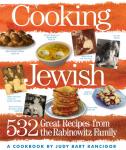
BUY COOKING JEWISH by clicking here now.
Purim: merriment, mirth…and good eats!
from Orange County Jewish Life magazine, March 2012. (Recipes for Layered Hummus and Eggplant with Roasted Garlic and Pine Nuts plus three varieties of Hamantaschen follow the story.)
Every Jewish school child knows the characters: Ahasuerus, the foolish king; Vashti, the spurned wife; Haman, the wicked first minister (sound your groggers now!); Esther, the brave and beautiful maiden; and Mordecai, her honorable protector. Their tale of intrigue is told in the Scroll of Esther (Megillah) as an annihilation plot is foiled and our people saved. Purim, which begins at sundown on Wednesday, March 7, is the holiday of merriment, mirth, and trickery!
To celebrate our deliverance, sweets are the order of the day. Gifts of cakes and fruit (shaloch manot) are exchanged. For Ashkenazim no Purim celebration would be complete without eating three-cornered hamantaschen, traditionally filled with poppy seeds, while Sephardim
enjoy honeyed pastries called oznei Haman (Hebrew for Haman’s ears).
Bulletin! This just in! Taschen means “pockets,” and Haman never wore a three-cornered hat! (You just can’t believe anything you hear these days.)
Matthew Goodman, the "Food Maven" columnist of the "Forward," points out in “Jewish Food: The World at Table” that these Purim sweets were originally called mohntaschen, meaning “poppy seed pockets.” Over the years the word morphed into hamantaschen (“Haman’s pockets”), which supposedly held the lots (purim) he cast in order to choose the date
for the slaughter of the Jews.
According to chef, rabbi, historian and Jewish cooking expert, Gil Marks, the association of Haman with a three-cornered hat didn’t arise until the late seventeenth century.
Pockets, hat, whatever…eat and enjoy! Paula Shoyer offers three varieties in “The Kosher Baker”: Orange Poppy Seed Hamantaschen, Hamantaschen with Fruit Filling or Homemade Lemon Curd, and Chocolate Candy Hamentaschen filled with chocolate covered raisins (recipes
follow).
What is it about Purim and poppy seeds anyway? András Koerner states in “A Taste of the Past: Daily Life and Cooking of a 19th Century Hungarian Jewish Homemaker” that although poppy seeds have long been associated with the holiday, they were used during Purim well before the baking of hamantaschen. A religious twelfth century poem by Abraham Ibn Ezra, he says, recorded the eating of poppy seeds and honey for Purim. Marks explains further in his latest work, the “Encyclopedia of Jewish Food” (Wiley, $40) that the tradition arose because the Yiddish word for poppy seeds, mohn, is similar to the name Haman (Hamohn in Hebrew).
From Afikomen to Za’Atar the “Encyclopedia of Jewish Food” reveals everything you ever wanted to know about Jewish foods, culinary traditions, rituals and holidays. For Purim Marks presents other traditional delicacies that go way beyond the ubiqiotous hamantaschen.
We eat dishes with a filling, “alluding to the many intrigues, secrets, and surprises unfolding in the Purim story,” he writes. Both Ashkenazim and Sephardim also enjoy chickpeas, “the legumes alluding to a tradition that Esther, in order to keep kosher, ate only vegetarian foods while living in the king’s palace.” Hummus is my favorite chickpea dish, but don’t save this appetizer just for Purim!
Layered Hummus and Eggplant with Roasted Garlic and Pine Nuts
1⁄4 cup balsamic vinegar
1⁄2 cup olive oil
1 teaspoon sugar
1⁄2 to 1 teaspoon kosher (coarse) salt, or to taste
Freshly ground black pepper, to taste
1 1/2 to 2 pounds eggplant, cut into 1/4 inch slices
1⁄2 to 3⁄4 cup olive oil
Hummus with Roasted Garlic (recipe follows)
1⁄2 bunch cilantro or flat-leaf parsley, chopped (1/4 cup)
1/3 cup pine nuts, toasted
About 8 pita breads, cut into wedges
1. Prepare dressing: Whisk vinegar into olive oil in a small bowl. Add
sugar, salt, and pepper, and mix well. Set aside.
2. Heat 1 to 2 tablespoons oil in large, heavy skillet over medium-high
heat. Add eggplant, in batches, and fry until cooked, browned, and
slightly crisp, about 5 minutes per side. Continue cooking eggplant,
adding more oil as needed. Drain very well on ink-free paper towels.
Coarsely chop drained eggplant, and transfer to a bowl. Add salt to taste.
3. Whisk dressing, pour about 6 tablespoons over eggplant, or to taste,
and stir. Add salt to taste.
4. To assemble: Spread hummus evenly on large, flat decorative platter.
Top withchopped eggplant, spreading to within about 1 inch of edge of
hummus. Sprinkle withcilantro and toasted pine nuts. Serve with pita for
scooping.
Hummus with Roasted Garlic
1 head garlic
1 tablespoon plus 1/4 cup vegetable oil
1 can (15 ounces) chickpeas, drained
1/2 cup tahini (100 % sesame seed paste)
5 tablespoons fresh lemon juice
2 tablespoons water
1 teaspoon kosher (coarse) salt, or more to taste
1 teaspoon ground cumin
1/8 teaspoon white pepper
1/8 teaspoon cayenne pepper
1. Preheat oven to 400°F.
2. Slice off top of garlic head exposing cloves. Place garlic on square
of aluminum foil, and pour 1 tablespoon oil over exposed cloves. Twist
foil tight, and roast 40 minutes. Open foil and let cool.
3. Combine all remaining ingredients in food processor. Squeeze cooled
roasted garlic out of cloves and add to other ingredients. Process until
smooth.
Source: Adapted from “Cooking Jewish” (Workman) by Judy Bart Kancigor
Hamentaschen with Lemon Curd
Makes 4 dozen
3 large eggs
1 cup sugar
1/2 cup canola or vegetable oil
1 teaspoon orange juice
3 1/2 teaspoons baking powder
3 cups all-purpose flour, plus extra for dusting parchment and dough
1 cup fruit jam or preserves, canned apricot or poppy seed pie filling,
or homemade Lemon Curd (see below)
1. Preheat the oven to 350ºF. Line 2 large cookie sheets with parchment.
2. In a large bowl, mix together the eggs, sugar, oil, and orange juice, and mix well. Add the baking powder and flour and mix until the dough comes together. I like to use my hands for this because it kneads the dough well. Divide the dough in half.
3. Take another two pieces of parchment and sprinkle flour on one, place one dough half on top, and then sprinkle a little more flour on top of the dough. Place the second piece of parchment on top of the dough and roll on top of the parchment until the dough is about 1/4-inch thick. Every few rolls, peel back the top parchment and sprinkle a little more flour on the dough.
4. Use a glass or round cookie cutter about 2 to 3 inches in diameter to cut the dough into circles. Place a teaspoon of the filling in the center and then fold in 3 sides to form a triangle, leaving a small opening in the center. Pinch the 3 sides very tightly. Place on the prepared cookie sheets. Repeat with the rest of the dough and re-roll and cut any dough scraps you have.
5. Bake for 12 to 16 minutes, or until the bottoms are lightly browned. The baking time often depends of the type of cookie sheet used: cookies on darker sheets bake faster. Just watch the cookies until they look done—you do not want them to be brown on top because then they will be too hard. Slide the parchment onto racks to cool the cookies. Store covered with plastic or in an airtight container at room temperature for five days or freeze for up to three months.
Lemon Curd
2 large eggs plus 1 egg yolk
1/2 cup sugar
Zest (grated outer peel) of 1/2 lemon
3 tablespoons fresh lemon juice (from 2 large lemons)
3 tablespoons parve margarine
In a double boiler, combine the whole eggs, egg yolk, and sugar. Add the lemon zest and juice and stir. Cook the curd uncovered over simmering water stirring occasionally, until a think mixture is formed, about 25 minutes. Be patient and do not stir too much. If the water in the double boiler boils too fast, turn down the heat. Remove the bowl from the heat and whisk in the margarine in small pieces. Cool for 5 minutes and then cover with plastic and refrigerate overnight. To use immediately, place the bowl of lemon curd in a larger bowl containing about 2 inches of ice and 1 cup of cold water. Let the smaller bowl sit in the ice for 15 minutes and the curd will be ready to use.
Source: “The Kosher Baker” (Brandeis University Press) by Paula Shoyer
Orange Poppy Seed Hamentaschen
Makes 4 dozen
Dough
3 large eggs
1 cup sugar
1/2 cup canola or vegetable oil
1 teaspoon orange zest (grated outer peel)
1 teaspoon fresh orange juice (from zested orange)
1 teaspoon poppy seeds
3 1/2 teaspoons baking powder
3 cups all-purpose flour, plus extra for dusting parchment and sprinkling
Filling
1/2 cup poppy seeds
2 tablespoons sugar
1 teaspoon orange zest (grated outer peel)
3/4 teaspoon ground cinnamon
1 large egg white
2 tablespoons honey
2 teaspoons all-purpose flour
1. Preheat the oven to 350ºF. Line 2 large cookie sheets with parchment.
2. To make the dough: In a large bowl, mix together the eggs, sugar, oil, orange zest, orange juice, and poppy seeds. Add the baking powder and flour and mix until the dough comes together. I like to use my hands for this because it kneads the dough well. Divide the dough in half.
3. To make the filling: In a bowl, mix together the poppy seeds, sugar, zest, cinnamon, egg white, honey, and flour.
4. Take another two pieces of parchment and sprinkle flour on one, place one dough half on top, and then sprinkle a little more flour on top of the dough. Place the second piece of parchment on top of the dough and roll on top of the parchment until the dough is about 1/4-inch thick. Every few rolls, peel back the top parchment and sprinkle a little more flour on the dough.
5. Use a glass or round cookie cutter about 2 to 3 inches in diameter to cut the dough into circles. Place a teaspoon of filling in the center and then fold in 3 sides to form a triangle, leaving a small opening in the center. Pinch the 3 sides very tightly. Place on the prepared cookie sheet. Repeat with the rest of the dough and re-roll and cut any dough scraps you have.
6. Bake for 12 to 16 minutes, or until the bottoms are lightly browned. After 12 minutes, watch the cookies closely to avoid over baking them; you do not want them to be brown on top because then they will be too hard. Slide the parchment onto racks to cool the cookies.
Source: “The Kosher Baker” (Brandeis University Press) by Paula Shoyer
Chocolate Candy Hamentaschen
Makes 4 dozen
3 large eggs
1 cup sugar
1/2 cup canola or vegetable oil
1 teaspoon orange juice
1 teaspoon pure vanilla extract
1 tablespoon baking powder
2 1/4 cups all-purpose flour, plus extra for dusting parchment and
sprinkling
3/4 cup parve unsweetened cocoa
1 cup parve chocolate-covered raisins
1. Preheat the oven to 350ºF. Line 2 large cookie sheets with parchment.
2. In a large bowl, mix together the eggs, sugar, oil, orange juice, and vanilla. Add the baking powder, flour and cocoa and mix until the dough comes together. I like to use my hands for this because it kneads the dough well. Divide the dough in half.
3. Take another two pieces of parchment and sprinkle flour on one, place one dough half on top and then sprinkle a little more flour on top of the dough. Place the second piece of parchment on top of the dough and roll on top of the parchment until the dough is about 1/4-inch thick. Every few rolls, peel back the top parchment and sprinkle a little more flour on the dough.
4. Use a glass or round cookie cutter about 2 to 3 inches in diameter to cut the dough into circles. Place 4 chocolate-covered raisins in the center and then fold in 3 sides to form a triangle, leaving a small opening in the center. Pinch the 3 sides very tightly. Place on the prepared cookie sheet. Repeat for the rest of the dough and re-roll and cut any dough scraps you have.
5. Bake for 12 to 16 minutes, until the bottoms are lightly browned. Slide the parchment onto racks to cool the cookies.
Source: “The Kosher Baker” (Brandeis University Press) by Paula Shoyer

